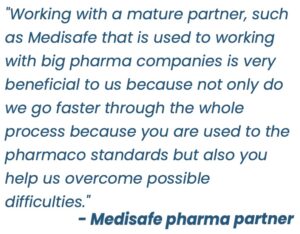PDURS: How Pharma Brand Marketing, Procurement Teams Can Prepare
Preparing for the FDA's draft guidelines on Prescription Drug Use Related Software
As the digital health landscape evolves, pharmaceutical companies must adapt to new regulatory frameworks that ensure patient safety and product efficacy. The FDA’s Draft Guidelines for Prescription Drug Use Related Software (PDURS) mark a significant step in this direction, providing comprehensive standards for software intended to support prescription drug use. For pharmaceutical brand marketers and procurement teams, understanding these guidelines and preparing for their implementation is crucial to maintaining compliance and leveraging the benefits of digital health innovations.
Understanding the FDA’s PDURS Guidelines
The FDA’s PDURS guidelines address software applications that support the use of prescription drugs. These include tools that provide dosing recommendations, track medication adherence, offer patient education, and analyze patient data to optimize treatment outcomes. The primary objectives of these guidelines are to ensure the safety and effectiveness of such software and to foster innovation in the digital health space.
Key elements of the guidelines include:
- Risk-Based Classification: Software is classified based on its risk to patient safety. High-risk applications require more rigorous evidence and controls than low-risk applications.
- Evidence of Effectiveness: Companies must provide robust evidence demonstrating that their software effectively supports the intended prescription drug use.
- User Interface and Usability: The guidelines emphasize the importance of user-friendly interfaces and clear instructions to ensure proper use by patients and healthcare providers.
- Interoperability: Software must integrate seamlessly with other digital health systems and electronic health records (EHRs).
- Post-Market Surveillance: Continuous monitoring and updating of the software are essential to address emerging safety concerns and improve functionality.
Preparing for Implementation
For pharmaceutical brand marketers and procurement teams, preparing for the PDURS guidelines involves several strategic steps:
- Collaborate with Regulatory Affairs: Work closely with your regulatory affairs team to understand the specific requirements of the PDURS guidelines and how they apply to your software products. This collaboration will ensure that your marketing strategies and procurement decisions align with regulatory expectations.
- Engage with Quality Assurance: Ensure that your quality assurance team is involved in the development and procurement of PDURS. This team will play a critical role in establishing processes for evidence generation, usability testing, and post-market surveillance.
- Invest in Training and Education: Equip your marketing and procurement teams with the necessary knowledge about PDURS. Training sessions, webinars, and workshops can help your teams understand the guidelines and how to implement them effectively.
- Assess and Update Existing Software: Conduct a thorough review of your current software portfolio to identify any gaps in compliance with the PDURS guidelines. Update or redesign existing software as needed to meet the new standards.
- Develop a Robust Evidence Base: Start early in generating the required evidence to demonstrate the effectiveness of your software. This may involve clinical trials, real-world evidence studies, and other research activities to support your claims.
- Focus on User-Centric Design: Prioritize the usability and user experience of your software. Engage with patients and healthcare providers to gather feedback and make necessary improvements. A user-friendly interface will enhance the adoption and effectiveness of your software.
Choosing the Right Vendors
Selecting the right vendors is critical to the successful development and implementation of PDURS-compliant software. Here are some key considerations for choosing the best partners:
- Regulatory Expertise: Look for vendors with a strong track record of navigating FDA regulations and experience in developing software that meets stringent regulatory standards. Medisafe, for example has worked with more than 20 Top Pharma companies and launched through various MLR processes with partner filings with the FDA.
- Proven Technology and Innovation:
 Partner with vendors that offer cutting-edge technology and innovative solutions. They should have a demonstrated ability to create effective, user-friendly software that integrates well with other digital health systems.
Partner with vendors that offer cutting-edge technology and innovative solutions. They should have a demonstrated ability to create effective, user-friendly software that integrates well with other digital health systems. - Collaborative Approach: Choose vendors that are willing to work closely with your teams throughout the development process. A collaborative approach ensures that the final product meets your specific needs and regulatory requirements.
- Comprehensive Support: Opt for vendors that provide comprehensive support, including training, implementation, and post-market surveillance. This support will be crucial in maintaining compliance and addressing any issues that arise after the software is launched.
- Positive References and Case Studies: Evaluate potential vendors by reviewing their references and case studies. Success stories from other pharmaceutical companies can provide valuable insights into a vendor’s capabilities and reliability.
Conclusion
The FDA’s new Draft Guidelines for Prescription Drug Use Related Software represent a significant advancement in the regulatory landscape for digital health. For pharmaceutical brand marketers and procurement teams, preparing for these guidelines is essential to ensure compliance and capitalize on the opportunities presented by digital health innovations. By collaborating with regulatory and quality assurance teams, investing in training, updating existing software, and choosing the right vendors, pharmaceutical companies can successfully navigate the new guidelines and enhance the effectiveness of their digital health tools.
Let’s Talk About Medisafe and PDURS:
You may also like
How AI Can Help Make HCPs “More Human”
Emre Ozcan, PhD, SVP, Head of Global Digital Health, Merck KGaA Darmstadt Germany and Omri Shor, CEO and Founder, Medisafe
..Read MoreInnovating Rare Disease Treatment: Integrating Digital Tools from Day One
In this webinar, UCB Pharma and the Les Turner ALS Foundation joined Medisafe discuss the integration of digital tools in
..Read MoreWant to Learn More?
We bring decades of experience to your challenges—and technology and solutions uniquely designed to meet your needs.
